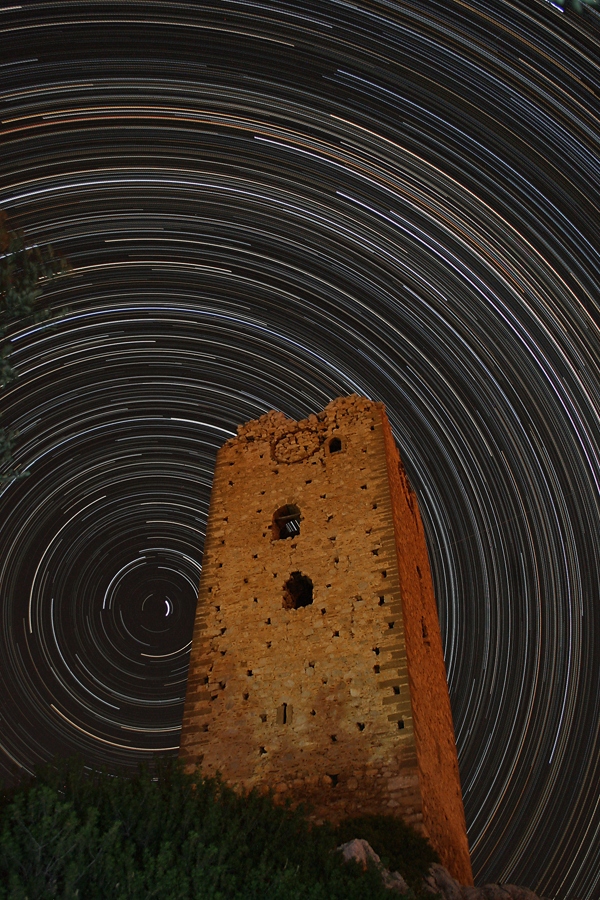
One of the most basic types of astrophotography and yet equally stunning is that involving star trails, particularly
around the celestial poles or immediately due east or west. In addition to capturing the motion of stars around the
north pole which are circumpolar and, hence, never rise or set, we also have the ability to capture seasonal
constellations and stars in such photos, thus allowing for different opportunities during different seasons. Star trail
photos also provide direct evidence that our planet rotates and does so at a rate of 15° per hour. Furthermore, by
studying the arc for a particular star, especially as far away from the pole as possible, one can indirectly estimate
the length of the (total) exposure which often ranges from seven to eight hours in duration and is totally dependent
on the end of astronomical twilight one evening and its onset
the following morning.
Many star photos are centered on Polaris, a double star system which represents our quickest means to locating the
north celestial pole, for it lies less than 1.0° from it, and is an excellent starting point for the polar alignment
of a telescope (and finding your way home if you are lost!). Due to the extended length of the typical exposures
involved, the best film for such work is Kodak Elite Chrome (ISO 100) whose reciprocity failure is nearly zero or
Fujichrome Velvia and Provia (ISO 50 and 100) emulsions with equally impressive curves! With respect to equipment, it
is rudimentary, for a camera with extended exposure capability is required along with a firm tripod and shutter
release and locking cable. It is also preferable that the camera used have a mechanical shutter so that battery
consumption and power does not become an issue during mid-exposure. The final requirement is a location with dark
skies - the darker the better so that the trails and their colouration will be as bright and contrasty as possible -
with, preferably, an interesting foreground which can be used to enrich the final result.
Note: Two of the many byzantine towers which characterize Greece's second largest island,
Euvoia, are the Twin Towers at Mytikas in central Euvoia which lie approximately 1500 meters to the west of the 13th
century
Castle
Fyllon also from the Byzantine period.
Lying atop a hill forty meters above ground level, these well-preserved towers are separated by about 100 meters from
each other. The towers were built in the 15th century AD and certainly by 1429 AD due to references to a tower keeper
who not only monitored the flow of water from the nearby Lilintas River for the consequent irrigation of farm lands further
downstream but also observed for pirates and other unwelcome visitors to the general area. The northernmost tower is
perfectly square and measures 6.10 meters on each side with the entrance being six meters above the ground. Each side at
its top is characterized with a circular engraving and it is believed that some sort of clock was in place on each side
of the tower, thus making this tower also the oldest clock tower in Greece and, quite possibly, the Balkans. The second and
southernmost
tower measures 7.50 by 7.00 meters with small openings in the lower section, presumably for weapons,
and which suggests its use was for (defensive) military operations. Both towers hosted guards who constantly scanned the
horizon for possible enemy forces so as to timely alert the local residents to take refuge in the towers, the local
castles and/or the mountains and forests in the general vicinity.
(Northern Tower) |
||
|
Proper Star Name: Polaris Bayer Letter: á Ursae Minoris Tycho Catalog: TYC 4628-237-1 SAO Catalog: SAO 308 Luminosity 2290 +/- 282 x Sun Distance: 431 +/- 26 light yrs RA / Dec: 02h 39m 31s / +89° 17' 39" B-V Color Index: +0.570 mag Magnitude: 1.98 |
 |
Date: Aug 27-28, 2014 22:00 - 03:00 UT+3 Location: Mytikas, Euvoia, Greece Equipment: Canon EOS 350D Canon EOS EF-S 18-55 mm @ 22 mm / f5.0 Exposure(s): 291 min (291 x 60 sec) (RGB) 010 min (010 x 60 sec) (Dark) ISO 400 JPG Fine Image Format 3456x2304 Image Size Continuous Servo Mode Software: Startrails V2.3 Photoshop CS5 Processing: Dark Frame Reduction Layers and Lighten Resampling Unsharp Masking JPG Compression |